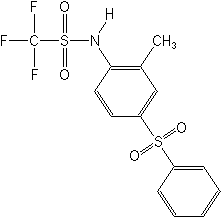|
Return
to Perfluidone Index Page
Activity:
Herbicide
(anilide)
Structure:

Adverse
Effects:
Liver
Environmental
•
Very little tox data available.
•
EU: Not allowed to be used after July 25, 2003
•
WHO: believed obsolete or discontinued
•
Perfluidone "acts as a classic
protonophore" - see abstract
below.
•
1985 - The [US EPA] is not conducting a tolerance reassessment
on perfluidone, because the only use is on flue-cured
tobacco. This use is a nonfood and non-feed use which
does not require a tolerance. Therefore, the Agency will
not require residue chemistry data on the metabolism of
perfluidone and related metabolite(s) in crops and animals.
CHEMICAL FACT SHEET FOR
PERFLUIDONE. FACT SHEET NUMBER: 74. DATE ISSUED: SEPTEMBER
30, 1985.
http://www.fluorideaction.org/pesticides/perfluidone.fact.sheet.1985.htm
|
Liver
(click on for all fluorinated pesticides)
-- Subchronic toxicology
effects of perfluidone are as follows: - A 90-day dog feeding
study showed liver disorders (hepatic lesions,
hepatocyte vacuolation, hyaline degeneration, and biliary
stasis) at the two highest dose levels (400 and 800 ppm).
-- The Agency (US EPA) is not conducting a tolerance reassessment
on perfluidone, because the only use is on flue-cured tobacco.
This use is a nonfood and non-feed use which does not require
a tolerance. Therefore, the Agency will not require residue chemistry
data on the metabolism of perfluidone and related metabolite(s)
in crops and animals.
Ref: Chemical Fast Sheet for Perfluidone.
Number 74. Date Issued: September 30, 1985.
http://www.fluoridealert.org/pesticides/perfluidone.fact.sheet.1985.htm
Abstract: The influence
of perfluidone (37924133) on oligomycin inhibited mitochondrial
respiration was investigated in-vitro. Mitochondria were prepared
from albino Wistar-rats and incubated with pyruvate-malate, succinate,
or ascorbate N,N,N',N'-tetramethyl-p-phenylenediamine (TMPD) as
substrate. Aliquots of 50 nanomolar adenosine-diphosphate, oligomycin,
and perfluidone at concentrations from 0 to 160 millimolar (mM),
or carbonylcyanide-p-trifluoromethoxyphenyl-hydrazone (FCCP),
a classic protonophore, were added at specific time intervals.
Oxygen consumption was measured polarographically. The effect
of varying concentrations of perfluidone on oligomycin sensitive
mitochondrial adenosine-triphosphatase (ATPase) was also determined.
With succinate as substrate, respiratory rates increased from
29.5 nanogram atoms oxygen/milligram mitochondrial protein/minute
(ng/mg/minute) to 85.4ng/mg/minute after adding 40mM perfluidone.
The extent of respiration stimulation by perfluidone increased
with increasing concentrations. After adding FCCP at 1microM,
the oligomycin inhibited respiratory rate of 31.4ng/mg/minute
was increased to 151.3ng/mg/minute. The respiratory rate was increased
in a dose dependent fashion at perfluidone concentrations up to
80microM which gave a maximum stimulation of about 5 fold. At
higher concentrations of perfluidone the extent of stimulation
of respiration decreased. Similar results were obtained when respiration
was supported by pyruvate-malate. Maximum sensitivity to perfluidone,
about 5 fold stimulation, was obtained at 100microM and decreased
at higher concentrations. When ascorbate TMPD was used as the
substrate, a 2 fold stimulatory effect was obtained at 20microM
perfluidone; maximum effect was apparent at 80microM perfluidone
and respiration was decreased at higher concentrations. The authors
conclude that perfluidone probably increases the permeability
of the inner mitochondrial membrane to protons, as does FCCP,
and acts as a classic protonophore.
Ref: Olorunsogo OO et al. (1985). Sensitivity
Of Oligomycin-Inhibited Respiration Of Isolated Rat Liver Mitochondria
To Perfluidone, A Fluorinated Arylalkylsulfonamide. Toxicology,
Vol. 35, No. 3, pages 231-240
| Environmental
(click
on for all fluorinated pesticides)
--
Adsorption and leaching in basic soil types: Perfluidone
will leach through wet, neutral or slightly alkaline soils,
with a tendency toward greater leaching in soils having
low clay and organic matter. Leaching occurs to a
lesser extent in acidic soil.
-- Perfluidone is slightly toxic to freshwater fish species.
Studies regarding freshwater invertebrates are not acceptable,
and there are no marine/estuarine data. A detailed ecological
hazard assessment cannot be made until certain environmental
chemistry data requirements have been met.
Ref: Chemical Fast Sheet
for Perfluidone. Number 74. Date Issued: September 30, 1985.
http://www.fluoridealert.org/pesticides/perfluidone.fact.sheet.1985.htm
|
|